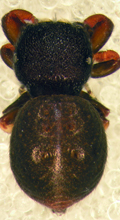Latest News Archive
Please select Category, Year, and then Month to display items
07 June 2019
|
Story Eugene Seegers
|
Photo Barend Nagel
 Tap on the red button labelled ‘Student Login’ at the bottom of the app to log in with your UFS student credentials.
Tap on the red button labelled ‘Student Login’ at the bottom of the app to log in with your UFS student credentials.
What? Your new KovsieApp is here!
How? Download this mobile app to your phone from the Apple App Store or Google Play Store.
Why? To access your information from the UFS website (current, registered students only ??).
It’s free! While you are connected to the on-campus Wi-Fi network.
Campus life just became a whole lot simpler. With the app, you can access personal information like study records, marks, class and exam timetables, mini fee statement, etc.
How to log in
Log in like this:
- Download the app, of course.
- Tap on the red button labelled ‘Student Login’ at the bottom of the app (see screenshot).
- Log in with your UFS student credentials.
- An OTP (one-time pin) will then be sent to the cellphone listed on your student profile. Do we have your correct number?
- Enjoy easy access to your personal UFS information with the KovsieApp! Unless…
… we don’t have your correct cellphone number. Please update your most recent contact number to get to your personal information in the app.
Updating your details
Please update your cellphone number by using the Student Self-service page on KovsieLife if you have trouble logging into or using the app.
Download Links
WATCH: Send the ravens!
UFS entomologists describe a new spider species
2014-02-19
|
 |
It is about 3mm in size and almost looks like a ladybird, but this new spider is the cause of great excitement at the University of the Free State’s (UFS’s) Department of Zoology and Entomology.
The new species of spider, now known as Rhene amanzi, was recently described for the first time and was ‘introduced’ to other arachnologist at the recent congress of the African Arachnology Society at Amanzi Private Reserve.
Dr Charles Haddad, senior lecturer in the UFS’s Department of Zoology and Entomology, said they already stumbled upon the male spider in 2010 when a student was doing research at the reserve. After a very long process, the spider was described and a couple of weeks ago, whilst at the congress, they also found the female.
“Up to now we only know that the spider lives in trees in the Brandfort area. The range could be wider, but since it was only described recently, other arachnologists will only now be able to identify accurately.”
Dr Haddad says they still have to determine how many eggs the female is able to lay, what the spider’s life cycle looks like and what their habitual preferences are.
“What we do know is that it probably isn’t poisonous and that the spider imitates a ladybird in order to protect itself against predators.”